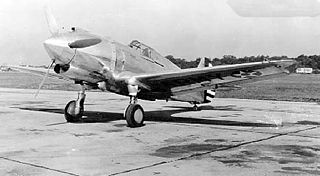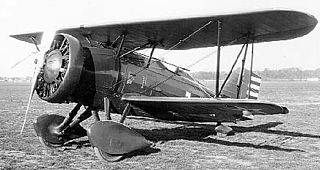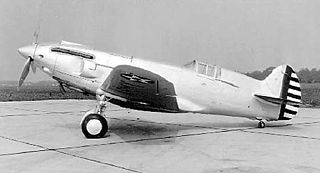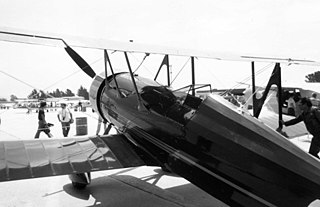
The Curtiss-Wright AT-9 Jeep was a twin-engined advanced trainer aircraft used by the United States during World War II to bridge the gap between single-engined trainers and twin-engined combat aircraft. The AT-9 had a low-wing cantilever monoplane configuration, retractable landing gear and was powered by two Lycoming R-680-9 radial engines.

The Curtiss XP-62 was a prototype single-engine interceptor aircraft, that was built at the request of the United States Army Air Forces, by the Curtiss-Wright Corporation. It first flew in 1943.

The Curtiss-Wright Model 21 was an American fighter-interceptor developed by the St. Louis Airplane Division of Curtiss-Wright Corporation during the 1930s.

The Curtiss SC Seahawk was a scout seaplane designed by the Curtiss Aeroplane and Motor Company for the United States Navy. The existing Curtiss SO3C Seamew and Vought OS2U Kingfisher were gradually replaced by the Seahawk in the late stages of the war and into peacetime.

The Curtiss XP-42 was an experimental fighter built by Curtiss Aircraft in the late 1930s to research engine cooling and improving the performance of the Curtiss P-36.

The Auster J/4 was a 1940s British single-engined two-seat high-wing touring monoplane built by Auster Aircraft Limited at Rearsby, Leicestershire.

The Curtiss-Wright CW-22 was a 1940s American general-purpose advanced training monoplane aircraft built by the Curtiss-Wright Corporation. It was operated by the United States Navy as a scout trainer with the designation SNC-1 Falcon.

The Curtiss R3C is an American racing aircraft built in landplane and floatplane form. It was a single-seat biplane built by the Curtiss Aeroplane and Motor Company.

The Curtiss Model 54 Tanager was an aircraft constructed in 1929 as Curtiss' entry in the Guggenheim Safe Aircraft Competition.

The Curtiss-Wright CW-1 Junior, originally named the Curtiss-Robertson CR-1 Skeeter is a light sports aircraft produced in the United States in the 1930s. It had been intended to sell it for the price of a mid-range automobile.

The Curtiss Fledgling, known internally to Curtiss as the Model 48 and Model 51 was a trainer aircraft developed for the United States Navy in the late 1920s and known in that service as the N2C.

The Curtiss-Wright CW-12 Sport Trainer and CW-16 Light Sport were high-performance training aircraft designed by Herbert Rawdon and Ted Wells and built in the United States in the early 1930s.

The Curtiss-Wright CW-19 was a civil utility aircraft designed in the United States in the mid-1930s and built in small quantities in a number of variants including the CW-23 military trainer prototype.

The Curtiss Model 55 Kingbird was an airliner built in small numbers in the United States in the early 1930s. It was a twin-engine aircraft with a fuselage derived from the single-engine Curtiss Thrush. The Kingbird had two engine nacelles mounted on the struts on either side of the fuselage that braced the wing and the outrigger undercarriage. A distinctive design feature was the aircraft's blunt nose, located behind the propeller arcs. This allowed the engines to be mounted closer to each other and to the aircraft's centerline, therefore minimising asymmetrical thrust in case of an engine failure. For the same reason, the Thrush's single tailfin was replaced by twin tails on the Kingbird, and the main production model, the D-2 fitted a second horizontal stabilizer and elevator between these fins.

The Curtiss YP-20 was an American biplane fighter project developed by Curtiss for the United States Army Air Service.

The Curtiss XP-22 Hawk was a 1930s American experimental biplane fighter built by Curtiss for evaluation by the United States Army Air Service.

The Curtiss P-37 was an American fighter aircraft made by Curtiss-Wright in 1937 for the US Army Air Corps. A development of the Curtiss P-36 Hawk to use an inline engine instead of the radial engine of the P-36 the fuselage was lengthened and the cockpit moved back. A small number of YP-37 aircraft was built for Air Corps evaluation. The expected top speed was not achieved and the project terminated in favor of the Curtiss P-40

The Curtiss CA-1 was an American five-seat biplane amphibian designed by Frank Courtney and built by Curtiss-Wright at St Louis, Missouri.

The Curtiss-Wright CW-14, named variously Travel Air, Sportsman, Speedwing and Osprey is an American 3-seat open cockpit single-bay biplane from the 1930s that was developed by Travel Air as a replacement for the highly successful Travel Air 4000. As a result of the Great Depression, which also limited sales, Travel Air merged into the Curtiss-Wright group of companies before production could start, so all examples were built by Curtiss-Wright. Its main claim to fame would be as the most numerous aircraft used in the Chaco war, where it formed the backbone of the Bolivian Air Force.
The Travel Air Model 10 was a 4-seat single-engined light aircraft of the late 1920s. Twelve aircraft were built before production ended.



















